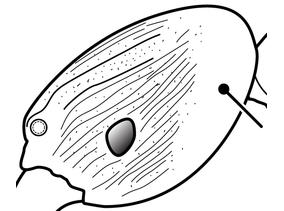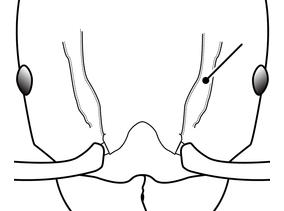TAXA (also search by using taxonomy search bar in header)
Pheidole navigans Forel, 1901
Nomenklatur
RINGKASAN
The following account of Pheidole navigans is from Sarnat et al. (2015).
Pheidole navigans is a small, short-limbed, reddish brown species that belongs to the P. flavens complex. See discussion under corresponding section of P. flavens complex for how to distinguish this species from introduced Pheidole outside the complex. Within the complex, minor workers are impossible to distinguish based on known characters. Major workers can be separated from those of P. flavens by the combination of predominantly longitudinal rugae on the posterolateral lobes, the more distinct and narrow antennal scrobe bordered mesially by strong, unbroken frontal carina, and the more continuously glossy scrobe depression.
Although the type locality of Pheidole navigans is Germany, the species was originally described by Forel from specimens intercepted during quarantine inspection of orchids originating from Veracruz, Mexico. We revise this name from synonymy and elevate it to species rank so that it can be applied to a putative species that has recently established in the southeastern United States and Hawaii. This ant has most often been referred to as P. moerens since it was first reported from Alabama nearly fifty years ago by M.R. Smith (1967). However, the examination of type specimen photographs (MCZ-ENT00009137) suggests that these introduced populations are heterospecific with P. moerens Wheeler.
Whether the introduced populations are actually conspecific with P. navigans Forel will require a thorough revision of this taxonomically vexing species complex. Of all the type material we have examined, however, that of P. navigans bears the closest resemblance in gross morphology. Thus we propose P. navigans Forel be used in place of P. moerens for referring to the aforementioned introduced populations. Future systematic study of this species should also examine P. floridana subsp. aechmeae (currently synonymized under P. flavens, but also recorded from Veracruz, Mexico) and P. flavens var. mediorubra Santschi (described from Loreto, Argentina and currently treated as a synonym of P. alacris Santschi).
The major workers of Pheidole navigans differ from those of P. moerens in the following respects. They exhibit a distinct and narrow antennal scrobe capable of receiving the entire antennal scape in repose. The scrobe is bordered by a strong, unbroken frontal carina mesially, and the depression is marked by a continuous smooth surface entirely (or nearly entirely) uninterrupted by rugulae. The rugulae of the frons extend to approximately an eye’s length distance from the posterior head margin. The anterior portion of the promesonotum is crossed by long and distinct transverse striae.
The examined major workers of P. navigans from Alabama (CASENT0106664) and Venezuela (CASENT0248831), along with those from Florida and Hawaii, and a specimen imaged from Paraguay (CASENT0178020), share a notably consistent morphology for being spread across such as wide range. The characteristics shared among these majors include the following. Frontal carinae strongly produced, forming the mesad border of a shallow but well-demarcated antennal scrobe capable of accommodating the entire scape in repose. Antennal scrobe weakly foveolate. Cephalic carinulae mostly longitudinal with very little reticulation posterior to the eye. Cephalic carinulae extending up to, but not beyond the medial excision (‘V’) of the posterior head margin. Promesonotal dome with a relatively low profile, mesonotal declivity short and relatively gradual. In dorsal view, promesonotum weakly punctate, anterior portion with distinct transverse carinulae. Although we tentatively treat the specimen from California (CASENT0005742) as P. navigans, it differs morphologically from the aforementioned specimens and bears closer resemblance to P. exigua var. tuberculata Mayr (currently synonymized under P. flavens).
The similarity of these northern hemisphere specimens to the one from Paraguay raises the possibility that these putatively conspecific populations originated in South America. Indeed, the Paraguay specimen was collected in the Reserva Natural del Bosque Mbaracayú near the Río Paraná—a region infamous for serving as a cradle of ant invasion (Suarez and Tsutsui 2008).






